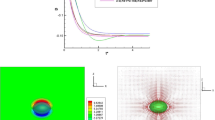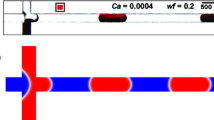Simulation of emulsion flows in differently shaped microchannels to reproduce the choking of such flows as a result of the effect of dynamic blocking has been made. A model of a highly concentrated emulsion as a structure of tightly packed deformed droplets surrounded by elastic shells is considered. The motion of liquid was determined by the method of the lattice Boltzmann equations together with the immersed boundary method. The influence of the non-Newtonian properties and of elastic turbulence of the indicated emulsion, as well as of the elasticity of the shells of its droplets and of the interaction of these shells on the emulsion motion in a microchannel, has been investigated. It is shown that the flow of this emulsion can be slowed down substantially only due to the mutual attraction of the shells of its droplets.
Similar content being viewed by others
References
G. Orlov, M. Kendis, and V. Glushchenko, Application of Invert Emulsions in Oil Production [in Russian], Nedra, Moscow (1991).
A. I. Nikiforov and D. P. Nikan′shin, Simulation of transfer of solid particles by a filtration flow, J. Eng. Phys. Thermophys., 71, No. 6, 933–938 (1998).
E. Yamaguchi and J. R. Adrian, Theoretical and experimental study of microchannel blockage phenomena, Abstracts and CD-ROM Proc. XXI Int. Congr. of Theoretical and Applied Mechanics (ICTAM04), Warsaw (2004), p. 31.
H. M. Wyss, D. L. Blair, J. F. Morris, H. A. Stone, and D. A. Weitz, Mechanism for clogging of microchannels, Phys. Rev. E, 74, 061402 (2006).
A. T. Akhmetov, A. G. Telin, M. V. Mavletov, and S. E. Zdol′nik, New principles of application of invert water-oil emulsions in flow-defl ection technologies and killing of wells, Neftegaz. Delo, 3, 119–126 (2005).
A. T. Akhmetov, V. V. Glukhov, M. V. Mavletov, and A. G. Telin, Effect of dynamic blocking in flow of stabilized highly concentrated invert water-oil emulsions, Tr. Inst. Mekh. Ufi msk. Nauch. Tsentra Ross. Akad. Nauk, Issue 4, 117–135 (2006).
A. T. Akhmetov and S. P. Sametov, Characteristic features of a dispersion of water microdroplets in microchannels, Pis′ma Zh. Tekh. Fiz., 36, Issue 22, 21–28 (2010).
A. A. Rakhimov, Yu. V. Burdyuk, and A. T. Akhmetov, Characteristic features of blood flow in capillaries at low pressure drops, Sovr. Probl. Nauki Obrazov., No. 3 (2012); http://www.science-education.ru/pdf/2012/3/301.pdf.
M. Sukop and D. Thorne, Lattice Boltzmann Modeling. An Introduction for Geoscientists and Engineers, Springer, Berlin (2006).
A. L. Kupershtokh, Three-dimensional modeling of two-phase systems of liquid-vapor type by the method of lattice Boltzmann equations on GPU, Vychisl. Metody Programmir., 13, 130–138 (2012).
A. I. Tyrinov , A. A. Avramenko, B. I. Basok, and B. V. Davydenko, Modeling of flows in a microchannel based on the Boltzmann lattice equation, J. Eng. Phys. Thermophys., 85, No. 1, 65–72 (2012).
J. Boyd, J. Buick, and S. Green, Analysis of the Casson and Carreau–Yasuda non-Newtonian blood models in steady and oscillatory flows using the lattice Boltzmann method, Phys. Fluids, 19, No. 9, 093103 (2007).
S. Hou, J. Sterling, S. Chen, and G. Doolen, A lattice subgrid model for high Reynolds number flows, Fields Inst. Commun., No. 6, 151–166 (1996).
Y. Cheng, H. Zhang, and C. Liu, Immersed boundary-lattice Boltzmann coupling scheme for fluid-structure interaction with flexible boundary, Commun. Comput. Phys., 9, 1375–1396 (2011).
J. Zhang, P. C. Johnson, and A. S. Popel, An immersed boundary lattice Boltzmann approach to simulate deformable liquid capsules and its application to microscopic blood flows, Phys. Biol., 4, 285–295 (2007).
T. G. Mason, New fundamental concepts in emulsion rheology, Curr. Opin. Colloid Interface Sci., 4, 231–238 (1999).
A. Ya. Malkin and I. Masalova, Characteristic features of the rheological properties and flow of highly concentrated emulsions — influence of concentration and of particle size, Kolloid. Zh., 69, No. 2, 206–219 (2007).
S. S. Datta, D. D. Gerrard, T. S. Rhodes, T. G. Mason, and D. A. Weitz, Rheology of attractive emulsions, Phys. Rev. E, 84, 041404 (2011).
I. V. Malanichev and F. G. Akhmadiev, Numerical simulation of the effect of dynamic blocking of invert emulsion flows, in: Proc. XXVI Int. Sci. Conf. "Mathematical Methods in Technique and Technologies" — MMTT-26, Vol. 3, 44–47 (2013).
Author information
Authors and Affiliations
Corresponding author
Additional information
Translated from Inzhenerno-Fizicheskii Zhurnal, Vol. 88, No. 6, pp. 1431–1438, November–December, 2015.
Rights and permissions
About this article
Cite this article
Malanichev, I.V., Akhmadiev, F.G. Simulation of Non-Newtonian Emulsion Flows in Microchannels. J Eng Phys Thermophy 88, 1483–1490 (2015). https://doi.org/10.1007/s10891-015-1334-z
Received:
Published:
Issue Date:
DOI: https://doi.org/10.1007/s10891-015-1334-z




